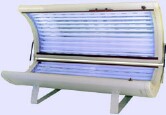
MONDAY, Feb. 25 (HealthDay News) — More than 40 percent of indoor tanning facilities doing business in Missouri — a state where the practice is unregulated — say that tanning is totally risk-free, a new survey reveals, with the vast majority indicating that their doors are wide open to children as young as 10.
The finding stems from what the researchers say is the largest poll of its kind to date, and could sound public health alarm bells, given the wealth of evidence indicating that tanning bed use significantly boosts the risk for developing skin cancer, particularly among younger patrons.
“There’s considerable evidence to show that at an early age the pigment cells of the skin may be more vulnerable to damage,” said study co-author Dr. Lynn Cornelius, chief of dermatology in the department of medicine at the Washington University School of Medicine, in St Louis. “And they’re going to get more of a lifelong exposure, which we also know is related to the risk for skin cancer,” she added.
“So the idea that people as young as 10 and 12 are allowed to tan indoors is a scary thing,” said Cornelius, also with the Alvin J. Siteman Cancer Center at Barnes-Jewish Hospital in St. Louis. “It highlights the need for new legislation, and the need to really educate parents to the risks to their kids inherent in tanning.”
The findings are published in the March issue of Pediatrics.
Roughly 3.5 million Americans are diagnosed with a non-melanoma skin cancer every year, with about 20 percent of the U.S. population projected to develop skin cancer at some point in their lives, according to study background information. Among young people aged 15 to 39, melanoma is now the third most-diagnosed cancer.
Many experts cite indoor tanning beds as a critical part of the problem, with studies showing their use increases the risk for common non-melanoma skin cancers by upward of 250 percent, and for melanoma by 75 percent to 300 percent.
Nonetheless, the $5 billion-a-year tanning industry serves 30 million Americans, about 2.3 million of whom are adolescent boys and girls.
The World Health Organization specifically recommends that minors under the age of 18 not use indoor tanning facilities.
In the United States, tanning machines are federally classified as “Class I” medical devices, the lowest risk designation possible, on par with items such as tongue depressors and bandages. So there are no mandatory national performance standards, and the U.S. Food and Drug Administration is limited to issuing recommended guidelines. However, the study authors recommend that tanning devices be reclassified to make them subject to regulatory oversight.
California and Vermont have recently implemented under-18 prohibitions, with legislation pending in Maine. New York has restrictions on indoor tanning for those under 17. And 33 states do have some type of regulation on the books, ranging from parental consent requirements to public postings of artificial UV [ultraviolet radiation] risk, mandatory skin assessments and the provision of eye protection. But many argue such regulations are poorly enforced. And 17 states currently have no indoor tanning regulations whatsoever.
Cornelius and her colleagues conducted a phone survey of indoor tanning operators in Missouri, where indoor tanning is unregulated.
In 2007, the team trained two medical students to pose as adolescent tanning customers when calling 243 tanning facilities throughout the state to inquire about operator protocols.
Among the responses, nearly two-thirds of the facilities said they would cater to customers as young as 10, while on average 43 percent said that indoor tanning was perfectly safe.
While 40 percent of the operators said that skin cancer is a risk, 20 percent said that any related risk was eliminated “if the customer takes precautions.” Four in five facilities said that indoor tanning would actually reduce the risk for getting a sunburn, while others suggested a range of related “health benefits.” And only about one in five said that a pre-tan skin assessment was necessary, or that precautionary measures should be taken, such as applying sunscreen.
An indoor tanning industry representative takes issue with both the study methods and its findings.
“This six-year old telephone survey is irrelevant when evaluating consumer safety procedures practiced in professional salons. This was data collected by phone interview six years ago — no one in this phone survey ever stepped foot in a sun-tanning salon, where parental consent standards and explicit consumer warning statements are already in place. Most of the non-salon businesses included in this survey are not even in business today,” said Tracie Cunningham, executive director of the American Suntanning Association.
The association “and professional tanning salons promote responsible new measures like strong parental consent laws and include warning signs in our businesses,” Cunningham added.
But one health expert is not impressed with industry safety efforts.
“The tanning industry today does not have very high standards for safety,” said Dr. Bruce Brod, chair of the American Academy of Dermatology’s State Policy Committee. “It’s very analogous to the tobacco industry, which used to actually claim that smoking was good for you before it became widely accepted that tobacco is carcinogenic,” he explained.
“And even in states with regulations, there are as many tanning salons as there are Starbucks and McDonald’s,” he added. “So it’s almost impossible to monitor compliance. But we do need more laws on the books, because laws raise awareness and send a message to the public that this is really dangerous.”
DeAnn Lazovich, an associate professor in the division of epidemiology and community health at the University of Minnesota in Minneapolis, agreed.
“There is confusion about the artificial nature of UV in tanning salons,” Lazovich said. “And there’s an overwhelming draw to tan skin as a marker of beauty and a sign of health. Especially among adolescent girls and young women, who are the predominant users. So we have to make it clear that any time the skin is exposed to UV, damage is occurring. There is no safe way to tan.”
More information
For more on state-by-state tanning regulations, visit the National Conference of State Legislatures.

